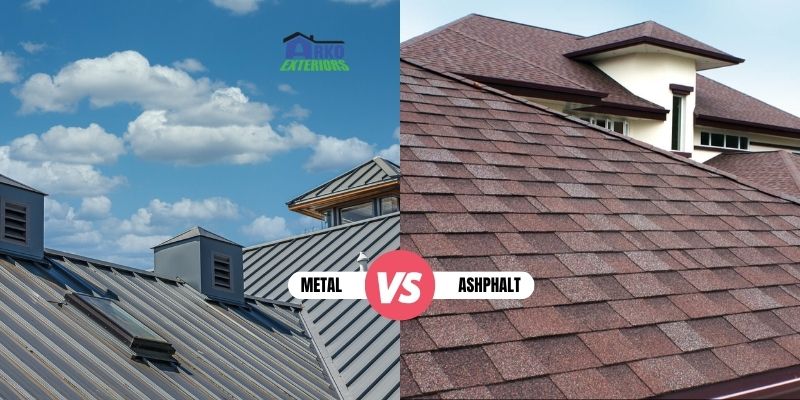Choosing the right roofing material for your home is an important decision that impacts everything from energy efficiency and home value to curb appeal and long-term maintenance costs. Two of the most popular roofing options on the market today are asphalt shingles and metal roofing. Both have their pros and cons that are worth considering carefully.
Asphalt shingles have long been the go-to roofing choice for many homeowners due to their affordability and ease of installation. However, metal roofing has gained significant traction in recent years as an increasingly attractive alternative. Metal roofs can outlast asphalt by decades, require less maintenance, and offer superior fire resistance and energy efficiency.
But affordability and up-front costs are major considerations as well. An asphalt roof typically costs much less for materials and labor than a metal roof installation. There are also aesthetic preferences to weigh, as some homeowners prefer the traditional look of asphalt shingles while others want the unique style of a metal roof.
In this detailed comparison, we’ll break down all the key factors to help you decide whether an asphalt or metal roof is the better investment for your home’s needs and budget. From lifecycle costs and energy savings to aesthetics and installation considerations, we’ll cover everything you need to make an informed decision.
Here is a more detailed explanation comparing asphalt and metal roofing on the key points:
1. Upfront Costs
Asphalt shingle roofing is generally much more affordable upfront than metal roofing. A typical asphalt roof for an average size home can cost between $5,000-$10,000 to install. Metal roofs tend to be 2-3 times more expensive for materials and labor, coming in at $15,000-$30,000 or more depending on the metal type, home size, and complexity of the roof.
2. Lifespan and Durability
When it comes to longevity, metal roofing has a significant advantage over asphalt. Asphalt shingle roofs usually need to be replaced every 15-30 years depending on the quality of materials and climate conditions. Metal roofs can last 40 years or more, with a lifespan of 60-70 years not being uncommon when properly installed and maintained. Metal is extremely durable and holds up well against impacts, high winds, hail storms, moisture, mildew, and other elements.
3. Energy Efficiency
Both roofing types can provide energy efficiency benefits, but metal tends to have an edge. The reflective nature of metal roofing allows it to better reflect radiant heat from the sun rather than absorbing it into the home’s interior. This can reduce cooling costs by up to 25% compared to asphalt. Some specialized asphalt shingles also have reflective coatings to promote cooler interior temperatures.
4. Weather Resistance
Metal roofing generally rates superior to asphalt when it comes to withstanding harsh weather events. Its impact resistance prevents hail damage better than asphalt. Interlocking metal panels withstand high winds far better than shingles which can be blown off. Metal roofs also have a Class A fire rating making them extremely resistant to catching fire from exterior sources. While asphalt is somewhat fire resistant as well, it is no match for the metal in severe fires. Asphalt does tend to perform acceptably in normal weather unless major storms strike.
5. Weight and Structural Requirements
Asphalt shingles are lightweight and can be installed over most existing roof structures without requiring reinforcement or adding structural support to bear the weight. Metal roofs are much heavier, and some older homes may need to have roof framing fortified or strapped to support the increased weight and wind loads. This can add to engineering and construction costs.
6. Maintenance and Repairs
One key advantage of metal roofs is their low maintenance requirements over decades of use. Besides occasional cleaning or tightening of fasteners, most metal roofs require little else. Asphalt shingles begin to deteriorate faster over time and typically need repair work within 10-15 years. Common needs are patching leaks, replacing cracked or lifted shingles, and reapplying protective coatings to prevent premature aging from sun exposure.
7. Aesthetics and Styles
Asphalt shingles provide a traditional look and are available in a variety of colors to match any home’s aesthetics. However, they have a uniform and relatively flat appearance. Metal roofing offers much more versatility with options like standing seam panels, metal shakes and shingles, tile or slate facsimiles, and more to achieve unique architectural styles from modern to rustic.
8. Environmental Impact
Since metal is a recyclable material at the end of its long lifespan, it has a lower environmental impact than asphalt. Tear-off waste from old asphalt roofs ends up occupying landfill space. Most quality metal roofing contains a high percentage of recycled material to start. Lighter-colored metal also helps reduce urban heat levels compared to heat-absorbing asphalt.
9. Installation Process
Asphalt roof installation is a straightforward process that doesn’t require specialized labor. Almost any roofing crew can do an asphalt tear-off and re-roof quickly using standard tools and techniques. Metal roof installation is more complex, often requiring a special crew with training on the specific system’s fastening, cutting, and weatherproofing methods. This adds time and labor costs.
10. Noise Levels
A common criticism of metal roofs is that they can create more noise disturbances than asphalt shingles during heavy rain or hailstorms. The noise is due to precipitation hitting the hard metal surface. However, when properly installed with solid sheathing and enclosed air spaces, the noise transmission is minimal and comparable to asphalt according to studies.
11. Resale Value
Both roof types can provide a strong return on investment for homeowners selling their property. However, metal roofs often have the advantage of resale value. Their longevity, energy efficiency, durability, and low maintenance make them increasingly sought after, especially in regions with severe weather. A metal roof’s transferable warranty also appeals to buyers.
12. Warranties
Top manufacturers of metal roofs like steel, aluminum, or copper typically provide 30-year to lifetime warranties against defects, corrosion, chipping, cracking, etc. Premium asphalt shingle warranties range from 20-30 years. Prorated coverage limitations exist with both after a certain timeframe. Warranties favor metal roofs for covering a longer expected service life.
Conclusion
Choosing between asphalt and metal roofing ultimately comes down to weighing your specific priorities and situation. Asphalt shingle roofs provide an affordable and traditional option that gets the job done sufficiently for most homeowners. They are relatively low maintenance for the first 10-15 years and can be replaced again in 15-30 years when needed.
However, metal roofing represents a wiser long-term investment for those willing to take on higher upfront costs. With lifespans often exceeding 50 years and in some cases over 100 years, a metal roof can easily outlast multiple cycles of asphalt replacements. Its superior durability, energy efficiency, weather resistance, and low maintenance requirements help offset the higher initial price tag over decades of ownership.
Metal roofing also delivers aesthetic benefits with sleek style options to elevate a home’s architectural appeal. Its environmental-friendly qualities and potential to increase resale value are added bonuses. That said, not every home may be suitable for the added weight and labor demands of metal roof installation.
Ultimately, there is noobjectively “best” choice that fits all situations. Your roofing decision should factor in your personal preferences, home characteristics, climate, budget, and long-term plans. With the key comparison points in mind, you can feel confident selecting the best roofing investment aligned with your goals and needs.

